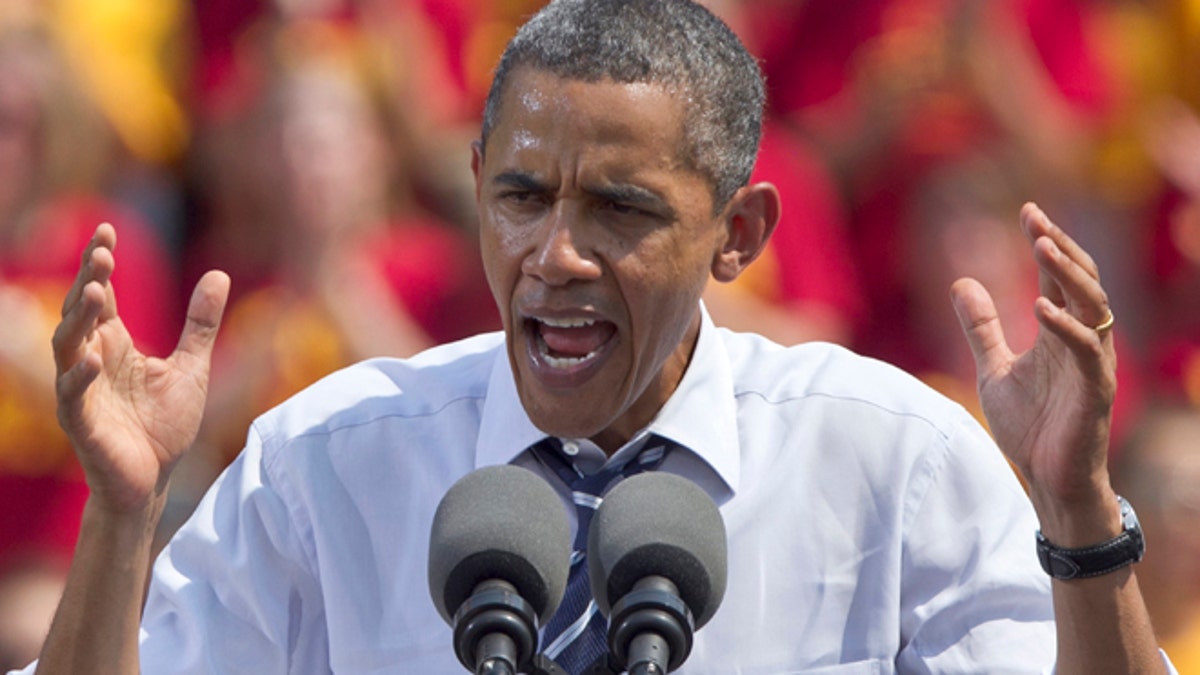
FILE: Aug. 28, 2012: President Obama speaks during a campaign stop in Ames, Iowa. (AP)
President Barack Obama has the edge over Republican Mitt Romney in three potentially decisive states in the presidential election.
Obama tops Romney by seven percentage points among likely voters in both Ohio (49-42 percent) and Virginia (50-43 percent). In Florida, the president holds a five-point edge (49-44 percent).
Obama’s lead is just outside the poll’s margin of sampling error in Ohio and Virginia, and within the margin of sampling error in Florida.
The good news for Romney is that among voters who are “extremely” interested in this year’s election, the races are much tighter. Obama is up by just two points with this group in Virginia (49-47 percent), Florida is tied (48-48 percent), and Romney is up by one point in Ohio (48-47 percent).
Independents are nearly evenly divided in each of the states, as well.
Majorities of voters are unhappy with how things are going in the country, yet in all three states more say they trust Obama than Romney to improve the economy.
Likewise, in each state more voters believe the Obama administration’s policies have helped rather than hurt the economy -- albeit by slim margins: By two points in Florida, three points in Ohio and five points in Virginia.
Amid the turbulent situation in the Middle East, each of the polls shows the president is more trusted than Romney on foreign policy.
Obama’s job approval rating and his personal favorability are 50 percent or higher in these three states. In Ohio and Virginia, the president’s favorable rating is 10 percentage points higher than Romney’s, and it’s 6 points higher in Florida.
In addition, Obama supporters are much more likely than Romney supporters to say they “strongly favor” their candidate: In Ohio by 23 percentage points, in Florida by 21 points and by 17 points in Virginia.
Click to view the Fox News Florida Poll
Click to view the Fox News Ohio Poll
Click to view the Fox News Virginia Poll
“Obama is nearly matching his 2008 support in these key states while Romney is under-performing compared to Republican John McCain,” says Democratic pollster Chris Anderson, who conducts the Fox News poll with Republican pollster Daron Shaw.
“And a significant enthusiasm deficit among Romney backers suggests he will have headwinds as he seeks to close the gap with the president and turn out his voters.”
Obama won these states in 2008: Florida by 51-47 percent, Ohio by 52-46 percent and Virginia by 52-47 percent. That was the first time a Democrat had won Virginia since 1964.
"The campaigns clearly believe the election may turn on what happens in Florida, Ohio, and Virginia,” says Shaw. “These are the top three states in terms of TV advertising by the campaigns and visits by the candidates.”
The president campaigned in Ohio on Monday and is scheduled to be in Florida on Thursday and Virginia on Friday. Romney plans to be in Florida on Wednesday and Thursday.
More voters than not say it is “pretty neat” to live in a hotly-contested state. Some 45 percent of voters in Virginia and 44 percent in Ohio feel that way, as do 40 percent in Florida. On the other hand, nearly a third in each state says it’s a “big pain.”
Senate Races
The poll also finds Democratic candidates for U.S. Senate topping the Republicans in each of the three states. In Florida, Sen. Bill Nelson is ahead of Republican Connie Mack by a margin of 49-35 percent.
In Ohio, incumbent Sen. Sherrod Brown has the advantage over Republican challenger Josh Mandel by 47-40 percent.
Democrat Tim Kaine is preferred over Republican George Allen by 47-43 percent in Virginia.
Governor Job Ratings
Over half of Virginia likely voters approve of the job Gov. Bob McDonnell (R) is doing (54-28 disapprove).
For Ohio Gov. John Kasich (R), 46 percent of Ohio likely voters approve and 38 percent disapprove.
In Florida, Gov. Rick Scott (R) receives negative ratings: 39 percent approve, while 49 percent disapprove.
The Fox News poll is conducted under the joint direction of Anderson Robbins Research (D) and Shaw & Company Research (R) from September 16 to September 18, 2012. The statewide polls are based on landline and cell phone interviews with randomly-chosen likely voters. The total sample of likely voters in each of the three states has a margin of sampling error of plus or minus 3 percentage points.




